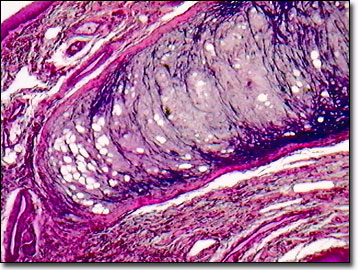Brightfield Digital Image Gallery
Epiglottis Elastic Cartilage
In order to prevent food from entering the air passages of the human larynx and trachea, a thin, leaf-shaped flap of tissue, the epiglottis, closes the opening into the larynx during swallowing. Composed mostly of elastic cartilage, the epiglottis joins the external ear and the auditory tube of the middle ear in utilizing the structural support and flexibility this type of connective tissue imparts.

Situated behind the tongue and in front of the voice box or larynx, at rest, the epiglottis is upright and allows air to pass through the larynx into the rest of the respiratory system. As swallowing commences, the epiglottis folds back to cover the larynx opening, preventing food matter and swallowed liquid from entering the windpipe. As the throat is composed of both the windpipe (an air passage) and the esophagus (a food passage), without this piece of elastic cartilage, air would enter the stomach and food would clog the lungs. After a swallow of food or liquid, the epiglottis returns to its resting orientation, the larynx rests, and the windpipe resumes airflow.
The little throat flap is composed of multilevel disk epithelium, flicker epithelium, and cartilage. At the core of the epiglottis is a thick elastic collagen support. In the elastic cartilage region of the epiglottis, cartilage-forming cells known as chondrocytes and chondroblasts, lacunae (the housing compartment for the chondrocytes within the matrix), and extracellular elastic fibers, are visible when magnified with a microscope. Groups of contiguous chondrocytes, referred to as isogenous groups, result from the division of a single precursor cell of the epiglottis. Surrounding the lacunae of chondrocytes, there is a secreted matrix or capsule that offers protection to this elastic cartilage. Adjacent to the cartilage, mucous-secreting glands help food slide down the alimentary canal.
With a sore throat, inflammation of the epiglottis tissue (epiglottitis) may occur, making swallowing and breathing more labored, and in some cases, life threatening. Coughing, a reflex reaction, may be set off by a malfunction of the epiglottis allowing food matter or liquids into the lungs, resulting in the explosive expulsion of air and foreign matter.
Contributing Authors
Cynthia D. Kelly, Thomas J. Fellers and Michael W. Davidson - National High Magnetic Field Laboratory, 1800 East Paul Dirac Dr., The Florida State University, Tallahassee, Florida, 32310.
BACK TO THE BRIGHTFIELD IMAGE GALLERY
BACK TO THE DIGITAL IMAGE GALLERIES
Questions or comments? Send us an email.
© 1995-2025 by Michael W. Davidson and The Florida State University. All Rights Reserved. No images, graphics, software, scripts, or applets may be reproduced or used in any manner without permission from the copyright holders. Use of this website means you agree to all of the Legal Terms and Conditions set forth by the owners.
This website is maintained by our
Graphics & Web Programming Team
in collaboration with Optical Microscopy at the
National High Magnetic Field Laboratory.
Last Modification Friday, Nov 13, 2015 at 01:19 PM
Access Count Since September 17, 2002: 38331
Visit the website of our partner in introductory microscopy education:
|
|
